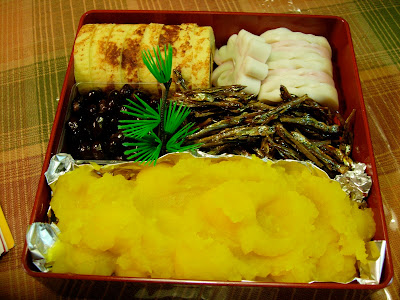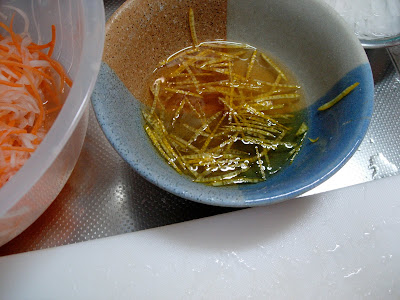

Top photo is spicy konnyaku.
Bottom photo is Shinji's bento. In the top half is white rice topped with salted and grilled salmon.
On the bottom half from the left: spicy konnyaku, simmered julienned gobo tossed in mayonnaise, eggplant and green pepper in a spicy miso sauce with sesame seeds, hijiki nimono, and hard boiled eggs with green beans and mayonnaise.
Konnyaku, also called devil's tongue jelly, comes in many forms. This one in the top photo came in a block that I cut into slices. It also comes in thin noodles and is called shirataki. This dense cake has a gelatinous and firm texture. Best of all, it is famous for having zero calories and will take on the flavor of whatever it is cooked in, but needs to be simmered for a long time as it is a dense and non-porous cake.
Before using it in the kitchen it needs to be parboiled in water. Alternatively, you can fry it in a nonstick pan until it literally squeeks. By doing this you will rid the konnyaku of some off flavors and it also firms up the texture of the konnyaku.
In the supermarket konnyaku is sold in clear, sealed plastic bags with some liquid. The liquid can be discarded. If you do not use all of the konnyaku, keep it in fresh water in the fridge. The water needs to be changed daily, as is also the case with tofu. Konnyaku will keep up to two weeks if the water is changed daily.
Tochigi prefecture, north of Tokyo, is where most of the konnyaku is grown and produced. The scientific name for konnyaku is Amorphophalus konjac. It is sometimes seen spelled konjac. The process of making konnyaku is fascinating. The root vegetable is grown (I believe for two years), then peeled, cooked, pounded, coagulated, and then formed into cakes or strings or balls.
The simple recipe for making the spicy konnyaku, also called kinpira follows.
1 block of konnyaku
3 Tablespoons sake
3 Tablespoons soy sauce
1 Tablespoon sugar (to taste)
1 dried red chili pepper, cut into small rings (alternatively, shichimi tougarashi)
Prepare the konnyaku by parboiling in ample water.
Slice the konnyaku into thin slices.
In a saute pan combine the sake, soy sauce, and sugar. Heat over medium heat until the sugar dissolves. Add the konnyaku and saute. Add the chili pepper and continue to saute until most of the liquid dissipates.


































































